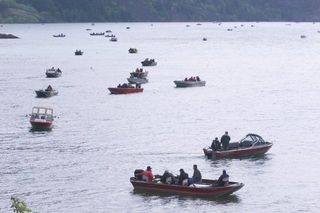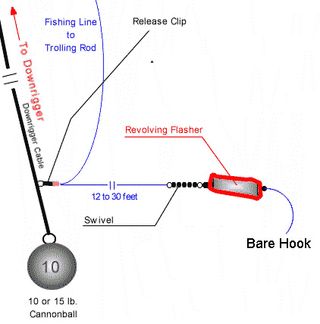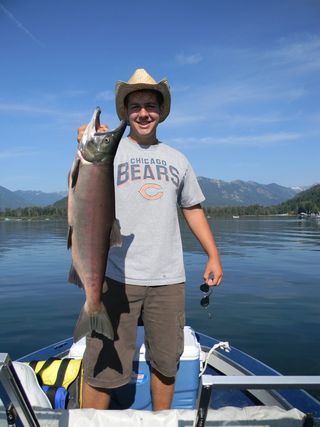In the Northwest, many of us love to fish. At times, it's too many. For me, nothing is more frustrating than investing a bunch of time and effort into a fishing expedition, only to find out that everyone else had the exact same idea.
 This happened to two of my sons recently, who went salmon fishing with a neighbor on Lake Wenatchee in central Washington.
At this particular spot, it is common to have to wait more than an hour
to launch your boat at 4:30am and then join hundreds of other boats who are all
competing to stake a claim in the lake's most productive fishing spots.
This happened to two of my sons recently, who went salmon fishing with a neighbor on Lake Wenatchee in central Washington.
At this particular spot, it is common to have to wait more than an hour
to launch your boat at 4:30am and then join hundreds of other boats who are all
competing to stake a claim in the lake's most productive fishing spots.
And all these anglers are not just fishing for the same fish, they are there at the same time, using the same fishing gear and deploying the same techniques to attempt to catch the salmon that have migrated into the lake. To make things even more frustrating, the salmon are at a point in their reproductive cycle where they are no longer eating.
 To get them to "bite," specialized
gear (flashy metal plates attached to down-riggers) is used to annoy the salmon and entice them to react. Think of someone waving something in
your face and instead of batting it away with your hands (salmon don't have
hands), they bite the annoying object in an attempt to get it to leave.
No bait or lures are used in the process, just a bare hook.
To get them to "bite," specialized
gear (flashy metal plates attached to down-riggers) is used to annoy the salmon and entice them to react. Think of someone waving something in
your face and instead of batting it away with your hands (salmon don't have
hands), they bite the annoying object in an attempt to get it to leave.
No bait or lures are used in the process, just a bare hook.
I know this all sounds a bit crazy if you've never been exposed to this type of fishing. But, there is a core underlying principle that makes this whole process work. Any idea what is it?
Large numbers of fish congregate in one place.
In Lake Wenatchee this year, there are about 60,000 sockeye salmon that enter the lake on their way upstream to spawn. About 10,000 will be caught while passing through the lake. The fish and wildlife scientists estimate that 25,000 salmon need to make it through the lake in order to produce a healthy spawn. Since about 50,000 will swim through the lake and continue up rivers and creeks to spawn, there will be fish in future years to continue the process.
What does all this have to do with recruiting? The same principle that causes salmon fishing to be successful in Lake Wenatchee causes your experienced agent recruiting efforts to be successful in your office:
You need to find where the candidates are congregating and make sure you're there.
Many hiring managers in the real estate industry are fishing in places where less and less candidates are congregating. For example, the number of experienced agents who are willing to receive, read, and respond to drip email campaigns is very small. And yet many hiring managers still expect this methodolgy to produce results. If everyone is fishing for the small number of these candidates, this "recuiting water" becomes overfished. Even if your techniques and exectuion are flawless, it will not produce a consisent flow of hires.
So, if the candidates you're after are not sitting in front of their email waiting for your drip email campaign, what are they doing? They are spending time on social networks. John Sumser, the founder and editor of HRExaminer Online Magazine, puts it this way in one of his recent blog postings:
"The essence of great recruiting is to fish where the fish are. As times change, the ‘recruiting waters’ get overfished. This is what makes the profession so highly flexible. Over the course of a decade, the success of one technique creates the demand for the next.
More than any other corporate function, recruiting involves adaptation to rapidly changing markets. Companies that shift their methods with the times, thrive. Companies that don’t, wither.
In 2012, that means learning how to use social media as a part of your recruiting effort. In a few short years, the center of the Internet moved from static sites to the more vibrant and interactive universe of online networks. Job boards give way to social media as users migrate to the new world.
Here are a few stats that put the story in perspective:
- 23% of all hours spent online are spent on a social media site
- 80% of all Internet users are members of at least one social network
- 66% of all Americans use a social network
- 25% of all American internet traffic is on Facebook alone"
 If you haven't done so already, it's probably
time to seriously consider making social media techniques part of your
recruiting strategy. The candidates are starting to pool in such
significant numbers that it only makes sense to put some of your recruiting
effort in this area.
If you haven't done so already, it's probably
time to seriously consider making social media techniques part of your
recruiting strategy. The candidates are starting to pool in such
significant numbers that it only makes sense to put some of your recruiting
effort in this area.
But, how do you become effective in this new recruiting arena? That's what we'll be discussing over the next month or so in WorkPuzzle. The good news is that your industry (and many other industries) are early in the process of figuring all this out. There are some boats starting to show up on the water, but everyone is still struggling to discover the techniques that produce results. Hopefully, we can get you pointed in the right direction.
The last picture is of Camden, my 15-year old son, who landed this big sockeye salmon. Living in the Northwest in a wonderful thing!
 Editor's Note: This article was written by Ben Hess. Ben is the Founding Partner and Managing Director of Tidemark, Inc. and a regular contributor to WorkPuzzle. Comments or questions are welcome. If you're an email subscriber, reply to this WorkPuzzle email. If you read the blog directly from the web, you can click the "comments" link below.
Editor's Note: This article was written by Ben Hess. Ben is the Founding Partner and Managing Director of Tidemark, Inc. and a regular contributor to WorkPuzzle. Comments or questions are welcome. If you're an email subscriber, reply to this WorkPuzzle email. If you read the blog directly from the web, you can click the "comments" link below.




Comments